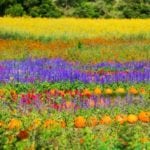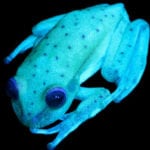 Weird Stuff
Weird Stuff  Weird Stuff
Weird Stuff  Mysteries
Mysteries 10 Tragic Disappearances and Deaths in Joshua Tree National Park
 History
History 10 Ways Childhood Really Sucked in the Old West
 Music
Music 10 Name Origins of Famous Bands from the 1990s
 Religion
Religion 10 Biggest Turnarounds by the Catholic Church
 Weird Stuff
Weird Stuff 10 Unbelievable Times Laws Had Unintended Consequences
 Humans
Humans Ten Historic Women Who Deserve Way More Credit Than They Got
 Movies and TV
Movies and TV 10 Films That Spawned Major Lawsuits
 History
History Ten Times Towns Were Wiped Off the Face of the Earth
 Creepy
Creepy 10 of the Most Disturbingly Haunted Public Houses in the UK
 Weird Stuff
Weird Stuff 10 Niche Subcultures That Are More Popular Than You Might Think
 Mysteries
Mysteries 10 Tragic Disappearances and Deaths in Joshua Tree National Park
 History
History 10 Ways Childhood Really Sucked in the Old West
Who's Behind Listverse?

Jamie Frater
Head Editor
Jamie founded Listverse due to an insatiable desire to share fascinating, obscure, and bizarre facts. He has been a guest speaker on numerous national radio and television stations and is a five time published author.
More About Us Music
Music 10 Name Origins of Famous Bands from the 1990s
 Religion
Religion 10 Biggest Turnarounds by the Catholic Church
 Weird Stuff
Weird Stuff 10 Unbelievable Times Laws Had Unintended Consequences
 Humans
Humans Ten Historic Women Who Deserve Way More Credit Than They Got
 Movies and TV
Movies and TV 10 Films That Spawned Major Lawsuits
 History
History Ten Times Towns Were Wiped Off the Face of the Earth
 Creepy
Creepy 10 of the Most Disturbingly Haunted Public Houses in the UK
Top 10 Fascinating Carnivorous Plants
Out of all the strange plants in the world, who would have thought that you even get flesh eating plants? Well, maybe not so much “flesh” eating, as insect eating, but carnivorous none the less. All carnivorous plants can be found in areas where the soil has very little nutrients. These fascinating plants are categorized as carnivorous as they trap insects and arthropods, produce digestive juices, dissolve the prey and derive some, or most, of their nutrients from this process. The first book on these plants was written by Charles Darwin, in 1875, “Insectivorous Plants”. After further discoveries and research, it is believed that these carnivorous properties evolved on six separate occasions, from five different orders of flowering plants. These are now presented in over 630 different species of flowering plant.
There are five basic trapping mechanisms found in all these plants: Pitfall traps, Fly Paper traps, Snap traps, Bladder traps and Lobster pot traps. I would like to show you a couple of plants, using each mechanism, so that you can also see the differences between different genera.
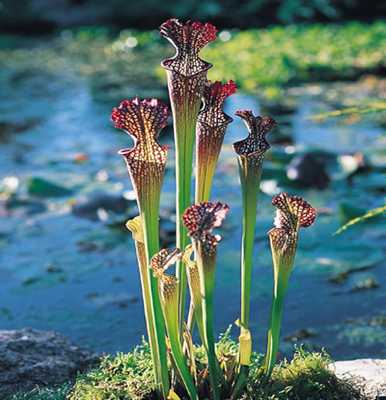
Sarracenia, or the North American Pitcher plant, is a Genus of carnivorous plants indigenous to the eastern seaboard, Texas, the great lakes and south eastern Canada, with most species being found only in the southeast states. It is also the first plant with a pitfall trap that we will look at.
The plant’s leaves have evolved into a funnel, with a hood like structure growing over the opening to prevent rain water from diluting the digestive juices. Insects are attracted by colour, smell and a nectar-like secretion on the lip of the pitcher. Slippery footings, aided in at least one species, by a narcotic drug lacing the nectar, causes insects to fall inside where they die and are digested by proteases and other enzymes
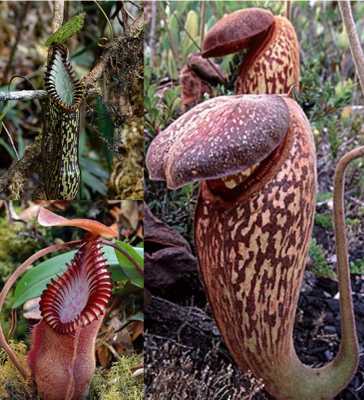
Nepenthes, tropical pitcher plants or monkey cups, are another genus of carnivorous plants with pitfall traps. There are about 130 species that are wide spread, and can be found in China, Malaysia, Indonesia, Philippines, Madagascar, Seychelles, Australia, India, Borneo and Sumatra. The nickname “monkey cups” comes from the fact that monkeys have often been observed drinking rain water from them.
Most species of Nepenthes are tall creepers (10-15m), with a shallow root system. From the stem you will often see sword like leaves growing, with a tendril (often used for climbing) protruding from the tip of the leaf. At the end of the tendril, the pitcher forms first as a small bulb, which then expands and forms the cup. The trap contains fluid, produced by the plant, which may be watery ors syrupy and is used to drown and digest the insects. The lower part of the cup contains glands that absorb and distribute nutrients. Most of these plants are small and tend to trap only insects, but some larger species, such as Nepenthes Rafflesiana and Nepenthes Rajah, have been documented to catch small mammals like rats.
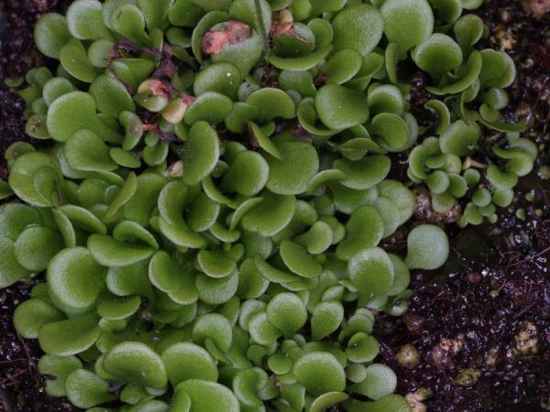
Genlisea, better known as the corkscrew plant, is made up of 21 species and generally grows in wet terrestrial to semi aquatic environments, and are spread across Africa, central and South America.
Genlisea are small herbs with yellow flowers that make use of lobster pot traps (Traps that are easy to enter but impossible to exit, like by use of small hairs growing towards the entrance or in this case, the ever forward propelling spiral). These plants have two distinct types of leaves – photosynthetic leaves above ground, and specialized underground leaves to attract, trap and digest minute organisms, like protozoans. These underground leaves also perform the duties of roots, like absorbing water and anchorage, as the plant does not have any. These underground leaves form hollow tubes under the ground, these tubes have a forward propelling corkscrew shape, and with the aid of constant water flow, small microbes can make their way into these tubes, but cannot find a way out again. When they reach the correct part of the tubes, they will be digested and absorbed.

Darlingtonia Californica, also called the California Pitcher plant or the Cobra Lilly, is the sole member of the darlingtonia genus, and is native to Northern California and Oregon. They grow in bogs and seeps with cold running water and, due to its rarity in the field, it is designated as uncommon.
The leaves of the Cobra Lily are bulbous and form a hollow cavity, with a opening situated underneath a swollen, balloon like structure and two pointed leaves hanging off the end like fangs. Unlike most pitcher plants, the Cobra Lilly does not make use of a pitfall trap, but rather lobster pot traps. Once inside, insects are confused by the large light speckles allowed to shine through the plant. When they land, there are thousands of fine dense hairs that grow inwards, they can follow the hairs deeper towards the digestive organs, but they cannot turn around or move backwards to escape.
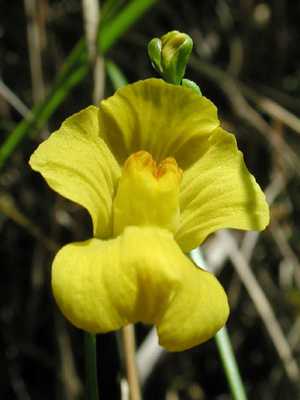
Utricularia, or collectively known as bladderworts, is a genus of carnivorous plants consisting of about 220 species. They occur in fresh water and wet soil as terrestrial or aquatic species, on every continent accept Antarctica.
They are the only carnivorous plants that make use of bladder traps. Most species have very small traps, in which they can catch only minute prey, like protozoa. Traps can range from 0.2mm – 1.2cm, with larger traps, trapping larger prey like water fleas and even small tadpoles.
The traps have small trigger hairs attached to a trapdoor. The bladder, when set, is under negative pressure in relationship to its surrounding area. When the trigger hairs are tripped, the trap door opens up, sucks in the insect and surrounding water, and closes the door again, all in a matter of 10 thousands of a second.
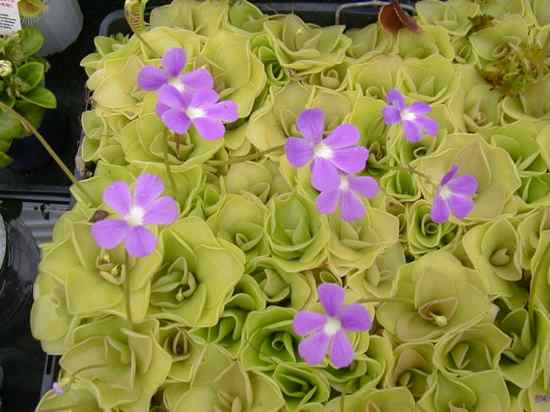
Pinguicula, or butterworts, are a group of carnivorous plants that use sticky, glandular leaves to lure, trap and digest insects. The nutrients from the insects supplement the poor mineral content of the soil. There are roughly 80 species that can be found throughout North and South America, Europe and Asia.
The leaves of the butterwort are succulent and usually bright green or pinkish in color. There are two special types of cells found on the top side of the butterwort leaves. One is known as a penduncular gland, and consists of secretory cells on top of a single stalk cell. These cells produce a mucilaginous secretion which forms visible droplets across the leaves surface, and acts like flypaper. The other cells are called sessile glands. They lie flat on the leaves surface and produce enzymes like amylase, esterase and protease, which aid in the digesting process.
Where some butterwort species are carnivorous all year round, many types form a tight winter rosette, which is not carnivorous. When summer comes, it brings with it new blooms and a new set of carnivorous leaves.
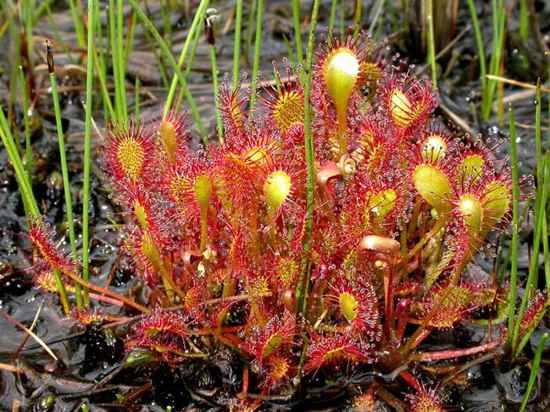
Drosera, commonly known as sundews, comprises one of the largest genera of carnivorous plants, with at least 194 species. These can be found widely spread on every continent accept for Antarctica. Sundews, (depending on what species) can form either prostrate or upright rosettes, ranging from 1cm to 1m in height, and can live up to 50 years.
Sundews are characterized by movable glandular tentacles, topped with sweet sticky secretions. When an insect lands on the sticky tentacles, the plant is able to move more tentacles in the direction of the insect to trap it further. Once trapped, small sessile glands will digest the insect and absorb the resulting nutrients, which can then be used to aid growth.
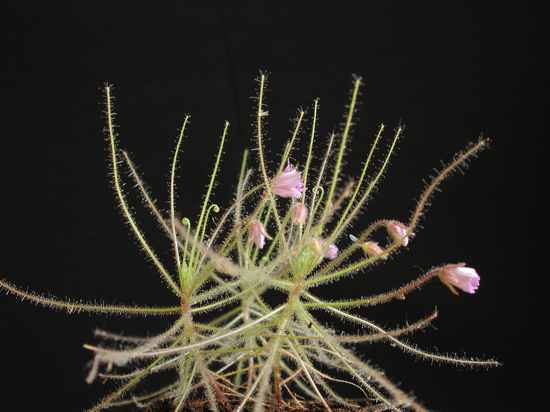
Byblis, or rainbow plant, is a small genus of carnivorous plant native to Australia. The name rainbow plant comes from the attractive appearance of their mucilage covered leaves in the sun. Even though these plants look similar to the Drosera and Drosophllum, they are not related in any way and can be distinguished by zygomorphic flowers with five curved stamens.
The leaves have a round cross section, and they tend to be very elongated and tapered at the end. The surface of the leaves are completely covered in glandular hairs that release a sticky mucilaginous substance, which in turn traps small insects on the leaves or tentacles as a passive flypaper trap.

Aldrovanda vesiculosa, also known as the waterwheel plant, is a fascinating rootless, carnivorous, aquatic plant. It generally feeds on small aquatic vertebrates, using a trap mechanism called a snap trap.
This plant consists mainly of free floating stems, reaching 6 – 11cm in length. The 2-3mm trap leaves grow in whorls of 5-9, in close succession along the plant’s central stem. The traps are attached to petioles, which contain air, and assists in floatation. This is a very fast growing plant and can reach 4-9mm per day, in some instances even producing a new whorl every day. As the plant grows from one end, the other end will continuously die off.
The traps basically consists of two lobes which fold together to make the snap traps. The openings of the trap point outwards, and are covered in a fine coating of trigger hairs, which will cause the trap to snap shut around any prey that comes too close. The trap closes in only 10 milliseconds, making it one of the fastest examples of plant movement in the animal kingdom.
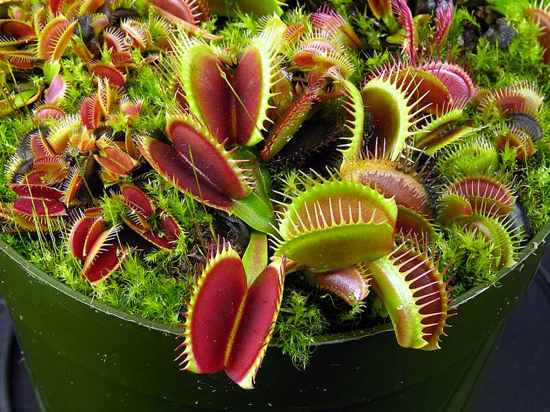
Dionaea Muscipula, more commonly known as a Venus flytrap, is probably the most well-known carnivorous plant and it feeds mainly on insects and arachnids.
The Venus flytrap is a small plant that has 4-7 leaves that grow from a short subterranean stem. The leaf blade is divided into two regions: a flat, long, heart shaped, photosynthesis capable petiole, and a pair of terminal lobes, hinged at the midrib, forming the trap which is actually the true leaf. The inner surfaces of these lobes contain a red pigment and the edges secrete mucilage.
These lobes exhibit rapid plant movement by snapping shut when special sensory hairs are stimulated. The plant is so advanced that it can tell the difference between live stimulus and non-living stimulus. The lobes snap shut in about 0.1 seconds. They are fringed by stiff thorn-like protrusions or cilia, which mesh together and prevent large prey from escaping. Once prey is unable to escape and the inner surfaces of the lobes are continuously being stimulated, the edges of the lobes grow or fuse together, sealing the trap and creating an enclosed “stomach” in which digestion and absorption can take place.

